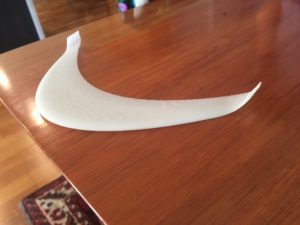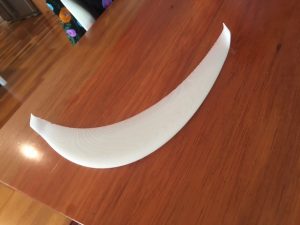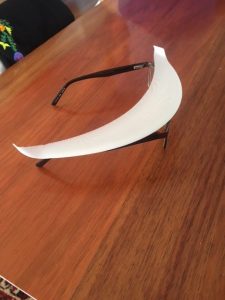
Author: dion
Gemot 3D printed.
My friend managed to 3D print a mini model of Gemot. It came out quite well considering it’s so small, although it wont fly as the material it’s made of is too dense.



The start of a new blog.
Yes, well I finally got around to creating this blog for FoilDB.com. I will be bringing the relevant blog posts over from 7xrobotics.com soon. Rather than write another blogging system, I thought I’d just use WordPress. It’s worked fairly well in the past.
RC second flight with control surfaces. Code name – Gemot.
Finally found some time to put some control gear into #Gemot. Gemot lay in the back of my van snapped in two for several weeks and I’d kind of forgotten about her. Then I thought to myself that I just want to prove that she may fly enough with RC control gear in her. I’d probably crash her in the first two minutes, but that would be long enough to prove the theory.
Well it flew a lot longer than that and was far more stable in the sky than I expected. I didn’t even glue the crack together. Duct tape seemed to do the job well enough. Gotta love that ‘Bear’ brand duct tape from Bunnings!
Looking for a supplier of EAPs.
Something we’ve been looking into is the implementation of EAP (Electro Active Polymers). EAP’s are basically the same as muscles found in animals, except that they’re manufactured product. We would like to use them in the aircraft in the previous Vlog entry. We can put standard ailerons on this plane, but it would be far more effective for fluid flow if we could merely contort the foil using flat format EAPs. That way we could spread the EAPs across the wing pulling on different points of the wing controlling the twist. Also with EAPs in series the total pull force on any point can be varied greatly. EAPs in different places would be able to hold the wing tips at the optimum zero lift point depending on the cruising airspeed required. This system could be automated using pressure sensors across the wing. If anyone knows of any suppliers of EAPs, please contact us here at 7x.
Testing Gemot – My first scratch built flying wing.
Here we’ve developed a prototype flying wing made from extruded polystyrene. The foam was easy to shape by hand, but it is very brittle as can been seen by the final impact on this video. Overall I am very happy with the outcome as the foil design worked perfectly. The wind was blowing up the hill varying in direction constantly at no more than 4 knots. The wing seemed to have adjusted to the different wind angles and speeds extremely well. In all prior flights it always self stabilized and landed the right way up.
200g of lead was used just in front of the centre of lift in this flight. The thickest point of the foil was ~ 20% from the leading edge with a thickness to chord ratio of about 13.8%. The central part of the foil does have a camber, but I didn’t exactly calculate it out apart from the fact that the leading edge was 1/3 up from the bottom of the foil.
The wing tips before the turned up winglets had symmetrical foils with the chord angled at about 17 degrees to that of the central main lift foil. This was to try to zero the lift at the wing tips to reduce tip vortex.
In conclusion the RC version would be extremely stable, but a better material is to be found for construction. The existing foil could be glued back together and skinned with a resin and glass construction, but that’s rather tedious. Also it won’t resist impacts on solid ground. We are currently looking for suppliers of EPO foam as it appears to work very well in other production models like the Ridge Rider available from HobbyKing.com
I’ve given this design the name #Gemot for easy reference. Strange name? Yes, so it doesn’t clash with too much on the net.
——–
I also added some footage from paper aeroplanes I’d made in 2007 at the start of Uni. Testing what I knew about tip twist from wind surfing and seeing how it works in horizontal flight.
